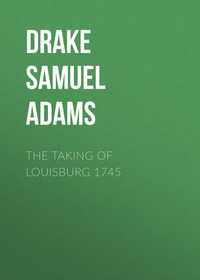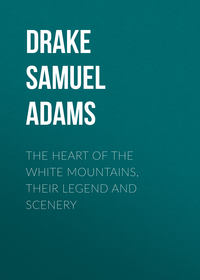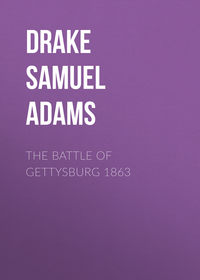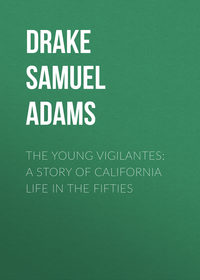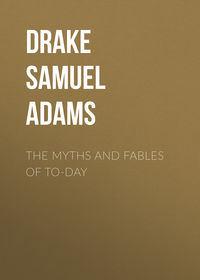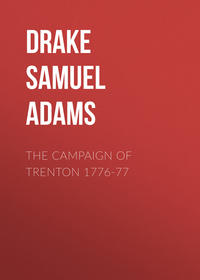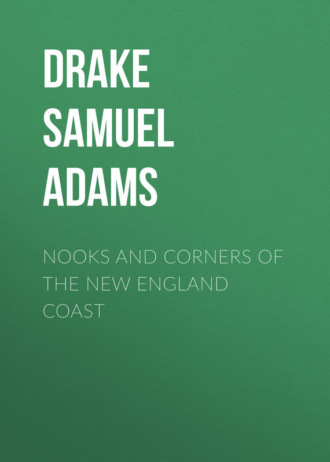 полная версия
полная версияNooks and Corners of the New England Coast
War continued between the Narragansets and Mohegans, the former, led by a brother of Miantonimo, being again the assailants. Uncas was at length compelled to throw himself within his strong fortress, where he was closely besieged, and in danger of being overpowered. He found means to send intelligence to Saybrook, where Captain Mason commanded, that his supply of food was exhausted. Mason immediately sent Thomas Leffingwell with a boat-load of provision, which enabled Uncas to hold out until his enemy withdrew. For this act, which he performed single-handed, Leffingwell received from Uncas the greater part of Norwich; and in 1659, by a formal deed, signed by Uncas and his two sons, Owaneko and Attawanhood, he, with Mason, Rev. James Fitch, and others, became proprietors of the whole of Norwich.327
I did not omit a visit to the ground where the "buried majesty" of Mohegan is lying. It is on the bank of the Yantic, in a secluded though populous neighborhood. A granite obelisk, with the name of Uncas in relief at its base, erected by citizens of Norwich, stands within the inclosure. The foundation was laid by President Jackson in 1833. Around are clustered a few mossy stones chiseled by English hands, with the brief record of the hereditary chieftains of a once powerful race.328 In its native state the spot must have been singularly romantic and well chosen. A wooded height overhangs the river in full view of the falls, where their turbulence subsides into a placid onward flow, and where the chiefs, ere their departure for the happy hunting-grounds, might look their last on the villages of their people. It was the Indian custom to bury by the margin of river, lake, or ocean. Here, doubtless, repose the bones of many grim warriors, seated in royal state, with their weapons and a pot of succotash beside them. The last interment here was of Ezekiel Mazeon, a descendant of Uncas, in 1826. The feeble remnant of the Mohegans followed him to the grave.329
Mr. Sparks remarks that the history of the Indians, like that of the Carthaginians, has been written by their enemies. As the faithful, unwavering ally of the English, Uncas has received the encomiums of their historians. His statesmanship has been justified by time and history. By alliance with the English he preserved his people for many generations after the more numerous and powerful Pequots, Narragansets, and Wampanoags had ceased to exist. In 1638 he came with his present of wampum to Boston, and having convinced the English of his loyalty, thus addressed them: "This heart" (laying his hand upon his breast) "is not mine, but yours. Command me any difficult service, and I will do it. I have no men, but they are all yours. I will never believe any Indian against the English any more." It is this invincible fidelity, approved by important services, that should make his name and character respected by every descendant of the fathers of New England.
About midway of the pleasant avenue that unites old Norwich with new is the birthplace of Benedict Arnold.330 Somewhat farther on, and when within half a mile of the town, you also see at the right the homely little building which was the apothecary's in which Arnold worked as a boy with pestle and mortar to the acceptance of his master, Dr. Lathrop, who lived in the adjoining mansion. One can better imagine Arnold dealing out musket-bullets than pills, and mixing brimstone with saltpetre rather than harmless drugs. As a boy he was bold, high-spirited, and cruel.
In this neighborhood I saw a group of elms unmatched for beauty in New England. One of them is a king among trees. They are on a grassy slope, before an inviting mansion, and are in the full glory of maturity. It was a feast to stand under their branching arms, and be fanned and soothed by the play of the breeze among their green tresses, that fell in fountains of rustling foliage from their crowned heads. A benison on those old trees! May they never fall into the clutches of that class who have a real and active hatred of every thing beautiful, or that appeals to more than their habitual perception is able to discover!
I made a brief visit at the mansion built by General Jedediah Huntington before he removed to New London after the Old War.331
In the dining-room was a full-length of General Eben Huntington, painted by Trumbull at the age of eighteen. On seeing it some years afterward, Trumbull took out his penknife and said to his host and friend, "Eb, let me put my knife through this." Another portrait by the same hand, representing the general at the siege of Yorktown, is in a far different manner. The three daughters of General Huntington, then living in the old family mansion, in referring to the warm friendship between their father and the painter, mentioned that the first and last portraits painted by Colonel Trumbull were of members of their family.
Near General Huntington's, where many of the choicest spirits of the Revolution have been entertained, is the handsome mansion of Governor Huntington, a remote connection of his military neighbor. Without the advantages of a liberal education, he became a member of the old Congress, and its president, chief-justice, and governor of Connecticut. President Dwight, who knew him well, extols his character and abilities warmly and highly.
I had frequent opportunities of seeing, in my rambles about the environs of New London and Norwich, the beautiful dwarf flowering laurel (Kalmia augustifolia) that is almost unknown farther north. In the woods, where it was growing in wild luxuriance, it appeared like a gigantic azelia, ablaze with fragrant bloom of white and pink. It used to be said that honey collected by the bee from this flower was poisonous. The broad-leaved laurel, or calico-tree (Kalmia latifolia) was believed to be even more injurious, instances being mentioned where death had occurred from eating the flesh of pheasants that had fed on its leaves.
Norwich town represents the kernel from which the city has sprung, and retains also no little of the savor incident to a population that has held innovations at arms-length. It has quiet, freshness, and a certain rural comeliness. A broad green, or common, planted with trees, is skirted by houses, many of them a century or more old, among which I thought I now and then detected the no longer familiar well-sweep, with the "old oaken bucket" standing by the curb. On one side of the common the old court-house is still seen.
Take the path beside the meeting-house, ascending the overhanging rocks by some natural steps, and you will be richly repaid for the trifling exertion. The view embraces a charming little valley watered by the Yantic, which here flows through rich meadow-lands and productive farms. Encompassing the settlement is another elevated range of the rocky hills common to this region, making a sort of amphitheatre in which the town is naturally placed.
The old church of Norwich town formerly stood in the hollow between two high hills above its present site. The pound, now its next neighbor, is still a lawful inclosure in most of the New England States. Not many years ago, I knew of a town in Massachusetts that was presented by a grand jury for not having one. I visited the old grave-yard, remarkable for its near return to a state of nature. Many stones had fallen, and sometimes two were kept upright by leaning one against the other. Weeds, brambles, and vines impeded my footsteps or concealed the grave-stones. I must often repeat the story of the shameful neglect which involves most of our older cemeteries. One is not quite sure, in leaving them, that he does not carry away on his feet the dust of former generations. Some of the stones are the most curious in form and design I have met with. The family tombs of Governor and General Huntington are here.
CHAPTER XXVIII.
SAYBROOK
"Says Tweed to Till,'What gars ye rin sae still?'Says Till to Tweed,'Though ye rin wi' speed,An' I rin slaw,For ae man that ye droon,I droon twa.'" —Old Song.Rather more than a hundred miles from New York the railway crosses the Connecticut River, on one of those bridges that at a little distance resemble spiders' webs hung between the shores. From here one may look down quite to the river's mouth, where it enters the Sound; and if it be a warm summer's day, the bluish-gray streak of land across it may be seen. The Connecticut is the only river of importance emptying upon the New England coast that has not an island lodged in its throat.
It was on one of those parched days of midsummer, when the very air is quivering, and every green thing droops and shrivels under a vertical sun, that I first alighted at the station at Saybrook. The listless, fagged, and jaded air of city swells lounging about the platform, the flushed faces of blooming girls and watchful dowagers, betokened the general prostration of weary humanity, who yearned for the musical plash of sea-waves as the withering leaves and dusty grass longed for rain.
How feminine New England exaggerates, to be sure! A group of three young ladies exchange their views upon the sultriness of the day: one observes, "What a dreadful hot day!" a second declares it "horrid" (torrid, perhaps she meant to say); and the last pronounces it "perfectly frightful," emphasizing the opinion by opening her umbrella with a sharp snap. What they would have said to an earthquake, a conflagration, or a shipwreck, is left to bewildering conjecture.
In a certain unquiet portion of the American Union, the term Connecticut Yankee is expressive of concentrated dislike for shrewd bargaining, a nasal twang of speech, and a supposed desire to overreach one's neighbor. How often have I heard in the South the expression, "A mean Yankee;" as if, forsooth, meanness were sectional! Here in New England a Connecticut Yankee is spoken of as a cunning blade or sharp fellow; as an Englishman would say, "He's Yorkshire;" or an Italian, "È Spoletino."
The day of wooden nutmegs is past and gone, and Connecticut is more familiarly known as the "Land of Steady Habits." The whole State is a hive. Every smoky town you see is a busy work-shop. The problem of the Connecticut man is how to do the most work in the shortest time, whether by means of a sewing-machine, a Colt, or a mitrailleuse. If I should object to any thing in him, it would be the hurry and worry, the drive, which impels him through life – and in this I do not imagine he differs from the average American man of business – until, like one of his own engines that is always worked under a full pressure of steam, he stops running at last. That is why we see so many old men of thirty, and so many premature gray hairs in New England.
But what I chiefly lament is the disappearance of the Yankee – not the conventional Yankee of the theatre, for he had never an existence elsewhere; but the hearty yet suspicions, "cute" though green, drawling, whittling, unadulterated Yankee, with his broad humor, delicious patois, and large-hearted patriotism. His very mother-tongue is forgotten. Not once during these rambles have I heard his old familiar "I swaow," or "Git aout," or "Dew tell."332 Railway and telegraph, factory and work-shop, penetrating into the most secluded hamlets, have rubbed off all the crust of an originality so pronounced as to have become the type, and often the caricature too, of American nationality the world over.
One peculiarity I have noticed is that of calling spinsters, of whatever age, "girls." I knew two elderly maiden ladies, each verging on three-score, who were universally spoken of as the "Young girls," their names, I should perhaps explain, being Young. Once, when in quest of lodgings in a strange place, I was directed to apply to the two Brown girls, whose united ages, as I should judge, could not be less than a century and a quarter. But one is not to judge of New England girls by this sample.
Another practice which prevails in some villages is that of designating father and son, where both have a common Christian-name, as "Big Tom" and "Little Tom;" and brother and sister as "Bub" and "Sis." One can hardly maintain a serious countenance to hear a stalwart fellow of six feet alluded to as "Little" Tom, or Joe, or Bill, or a full-grown man or woman as "Bub" or "Sis." On the coast, nicknames are current principally among the sea-faring element; "Guinea Bill" or "Portugee Jack," presupposes the owner to have made a voyage to either of those distant lands.
The Italians count the whole twenty-four hours, beginning at half an hour after sunset. By this method of computation I reckoned on arriving at Saybrook Point at exactly twenty-two o'clock. I walked through the village leisurely observant of its outward aspect, which was that of undisturbed tranquillity. Modern life had been so long in reaching it, that it had been willing to accommodate itself to the old houses, and so far to the old life of the place. The toilets here, as elsewhere, encroached in many instances upon those of the last century, and were wonderfully like the portraits one sees of the time. Now, let us have the old manners back again.
One of the pleasantest old houses in Saybrook is the Hart mansion, which stands in the main street of the village, heavily draped by the foliage of three elm-trees of great size and beauty. It was a favorite retreat of that gallant sailor, Isaac Hull, who lost his heart there.333 Like Nelson, he was the idol of his sailors, for he was as humane as he was brave. He seldom ordered one of his old sea-dogs to be flogged, but would call a culprit before him, and after scolding him soundly with affected roughness of tone and manner, would tell him to return to his duty. The Old Ironsides was loved with a love almost like that which man bears to woman. Ladies would have kissed the hem of her sails; men scraped the barnacles from her bottom, and carried them home in their pockets. I have seen no end of canes, picture-frames, and other souvenirs of this famous ship treasured by fortunate possessors; and one of the old merchants of Boston had his street door made of her oak.
Saybrook is languid. It is dispersed along one broad and handsome street, completely canopied by an arch of foliage. You seem, when at the entrance, to be looking through a green tunnel. In this street there is no noise and but little movement. The few shops were without custom. After the spasm of activity caused by the arrival of the train – when it seemed for the moment to rub its eyes and brisk up a little, carriages and pedestrians having mysteriously disappeared somewhere – the old town dozed again.
The Connecticut is here tame and uninteresting, with near shores of salt-marsh flatness. Yellow sand-bars, green hummocks, or jutting points skirted with pine-groves, inclose the stream, which is broad, placid, and shallow. There are no iron headlands, or dangerous reefs. Nature seems quite in harmony with the general quietude and restfulness.
A few years ago there existed at the Point the remains of a colonial fortress, with much history clustering around it. It was raised in the very infancy of English settlement at the mouth of the Connecticut; and when the Revolution came, the old dismounted cannon, that had perhaps done duty with Howard or Blake, were again placed on the ramparts. The railway people have reduced the hill on which it stood to a flat and dreary gravel waste.334 This is walking into antiquity with a vengeance! It is perhaps fortunate that the Coliseum, Temple Bar, and St. Denis are not where they would be valued for the cubic yards of waste material they might afford.
The Dutch anticipated the English in the settlement on Connecticut River. The Hollanders at Fort Amsterdam, and the then rival colonies of Plymouth and Massachusetts Bay, were each desirous of obtaining a foothold which each felt too weak to undertake alone. The country had been subjugated by the Pequots, whose territory neither colony might invade without bringing the whole nation upon them.
The Dutch were also first to visit the river, and to inform the Pilgrims of its beauty and advantages for traffic. In 1633, Massachusetts having rejected overtures for a joint occupation, Plymouth determined to establish a trading-post upon the river without her aid. Apprised of this intention, the Dutch dispatched an expedition, which disembarked where Hartford now is. A house was hastily erected, and ordnance mounted, with which the Hollanders gave notice that they meant to keep out intruders.
The Plymouth expedition, under command of William Holmes, ascended the river, and, notwithstanding an attempt to stop them, passed by the Dutch fort. They landed at Nattawanute, afterward Windsor, and, having made themselves secure, sent their vessel home. Word was sent to Fort Amsterdam of the invasion. A company of seventy dispatched to the scene advanced "brimful of wrath and cabbage," with drums beating and colors flying, against the English fort. Seeing the Pilgrims were in nowise disconcerted, the Dutch captain ordered a halt; a parley took place, and, having thus vindicated the national honor, Gualtier Twilley's men withdrew.335
The attempts of Plymouth to establish tributary plantations, with trading-posts, at the extreme eastern and western limits of New England, were equally disastrous. Massachusetts stood quietly by, and saw her rival dispossessed at Penobscot, but at Windsor the Plymouth people soon found themselves hemmed in between settlements made by emigrants from the bay. As a quarrel would perhaps have been alike fatal to both, Plymouth gave way to her more powerful neighbor.
The English settlement of Connecticut is usually assigned to the year 1635, the year of beginnings at Hartford, Wethersfield, and Saybrook. In the autumn the younger Winthrop sent a few men to take possession and fortify at the mouth of the Connecticut, as agent of Lords Say, Brook, and their associate owners of the patent.336 This expedition forestalled by a few days only a new attempt to obtain possession by the Dutch, who, finding the English already landed and having cannon mounted, abandoned their design.
Through the agency of the celebrated Hugh Peters, the patentees engaged, and sent to New England, Lion Gardiner, a military engineer who had served in the Low Countries. He arrived at Boston in November, 1635, and proceeded to the fort at the mouth of the Connecticut. He was followed by George Fenwick, sent over by Lord Say to be resident agent of the English proprietors. Fenwick, accompanied by Peters, reached the fort in the spring. The plantation was called Saybrook, as a compliment to the two principal personages interested in its founding.
Saybrook has perhaps acquired a certain importance in the eyes of historical writers to which no other spot of New England's soil can pretend. There is little room to doubt that Lord Say, and perhaps some of his associates, strongly entertained the idea of removing thither.337 A more debatable assertion, which is, however, well fortified with authorities, represents Oliver Cromwell, John Hampden, Pym, and Sir Arthur Haselrig as having been prevented from embarking only by an express order from the king: some, indeed, assert that they actually embarked.338
In the old burial-place of Saybrook Point is the most curious sepulchral memorial in New England. I can compare it with nothing but a Druid monument, it is so massy, so roughly shaped, and so peculiar in form. Until a few years ago, it stood within a field south-west of the fort, over the dust of George Fenwick's wife, a woman of gentle blood. The "improvements" made by the railway in this vicinity caused the removal of the monument to its present position. When the remains of Lady Fenwick were disinterred, the skeleton was found to be nearly entire. Beneath the skull was lying a heavy braid of auburn hair, which was parceled out among the villagers. My informant offered to show me the tress that had fallen to his share.
I acknowledge it, I am the fool of association; and when I see the spade thrust among graves, I wince a little. I would have Shakspeare's appeal and malediction inscribed over the entrance to every old grave-yard in New England. But, after all, what is Shakspeare's malediction to these trouble-tombs who anticipate the Resurrection, and give the burial service the lie. Our bones ache at the thought of being tossed about on a laborer's shovel. Rather come cremation than mere tenure at will at the tender mercies of these levelers. When we have been "put to bed with a shovel," and have pulled our green coverlet over us, let us have the peace that passeth all understanding.
Not much is known of Lady Anne Boteler, or Butler, the wife of George Fenwick. It is surmised that she died in childbed. The inscription that her monument undoubtedly bore has been so long obliterated that no record remains of it. A newer one, with the simple name and date, "Lady Fenwick, died 1648," has been cut in the perishable sandstone. Some one has also caused the cross to be chiseled there.339 Considering the peculiar aversion with which the Puritans regarded the cross, the appearance of one on the tombstone of Lady Fenwick is suggestive of the famous prohibition of the cemetery of Saint Médard:
"De par le roi, défense à DieuDe faire miracle en ce lieu."Dr. Dwight states, as of report, that Fenwick, before his return to England, made provision for having his wife's tomb kept in repair. The sale of the title of Lords Say and Brook by him, in 1644, to Connecticut, is considered evidence as well of the existence of the design of removal alluded to as of its abandonment. After the death of Lady Fenwick her husband returned to England, and is mentioned as one of the regicide-judges. He subsequently appears with the title of "colonel," and is believed to be the same person who besieged Hume Castle, in 1650, for Cromwell. On being summoned, the governor sent his defiance in verse:
"I, William of the Wastle,Am now in my Castle:And aw the dogs in the townShanna gar me gang down."340The English at Saybrook Point protected the land approach with a palisade drawn across the narrow isthmus, which very high tides overflowed and isolated from the main-land. Their corn-field was two miles distant from the fort, and skulking Pequots were always on the alert to waylay and murder them. Some of the Bay magistrates having spoken contemptuously of Indian arrows, Gardiner341 sent them the rib of a man in which one, after passing through the body, had buried itself so that it could not be withdrawn.
Gardiner's manner of dealing with Indians was peculiar. When the expedition against the Pequots was at Saybrook Fort, distrusting Mohegan faith, he resolved to make a trial of it. He therefore called Uncas before him, and said, "You say you will help Major Mason, but I will first see it; therefore send you now twenty men to the Bass River, for there went yesternight six Indians in a canoe thither; fetch them now, dead or alive, and then you shall go with Major Mason, else not." So Uncas sent his men, who killed four and captured one, the sixth making his escape.
The old burial-ground of Saybrook is neat and well kept. Lady Fenwick's monument is just within the entrance, concealed by a clump of fir-trees. Not a quarter of the graves have stones, and that part of the ground occupied by the ancients of the village is so mounded and overcrowded that you may not avoid walking upon them. In another spot head-stones jutted above the turf at every variety of angle, and several monuments had cavities, showing where they had been robbed of leaden coats of arms – to run into bullets, perhaps. All are of ample dimensions, and on older ones creeping mosses conceal the inscriptions. The variety of color presented by slate, sandstone, or marble upon green is not unpleasing to the eye, yet those reckonings scored upon slate shall endure longest.
In the Hart inclosure repose the ashes of the once beautiful Jeannette M. M. Hart, whose slab bears the symbol of her faith. She, the fairest of all the sisters, renounced the world and, embracing the Roman faith, became a nun. Her remains were brought home from Rome, and laid to rest with the service of the Church of England. In a little separate inclosure, whispered to have been consecrated by the rite of Rome, another sister is lying. When Commodore Hull cruised in the old frigate United States, one of these beautiful girls was on board his ship. She was seen by Bolivar, who fell desperately in love with her at a ball, and became so attentive that the American officers believed they were betrothed.342



